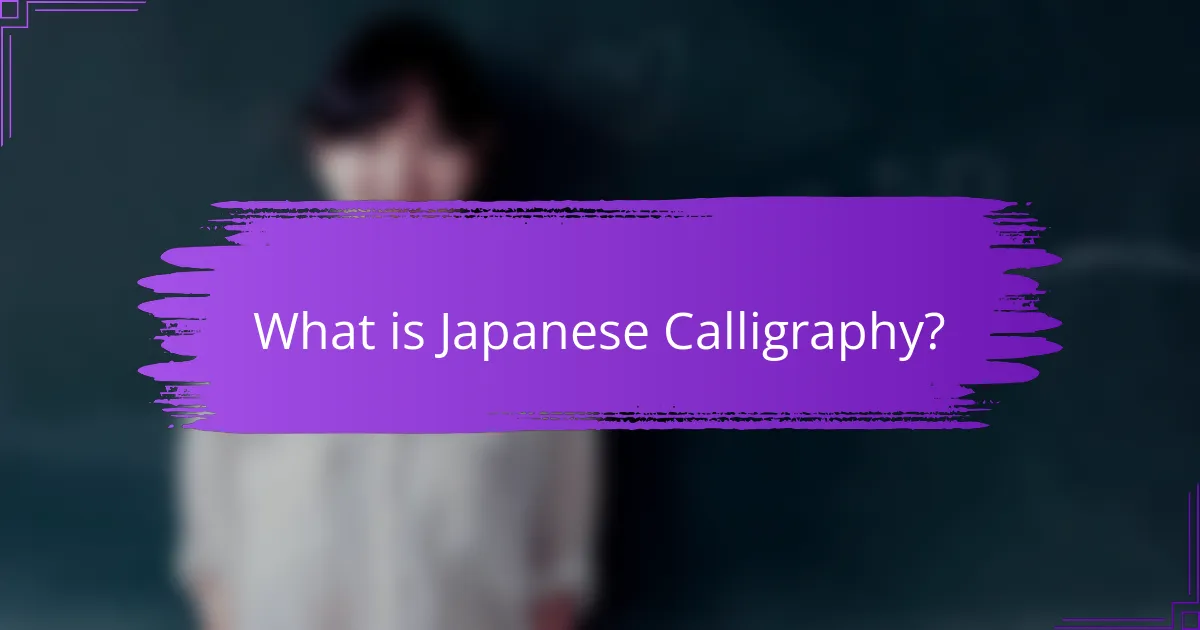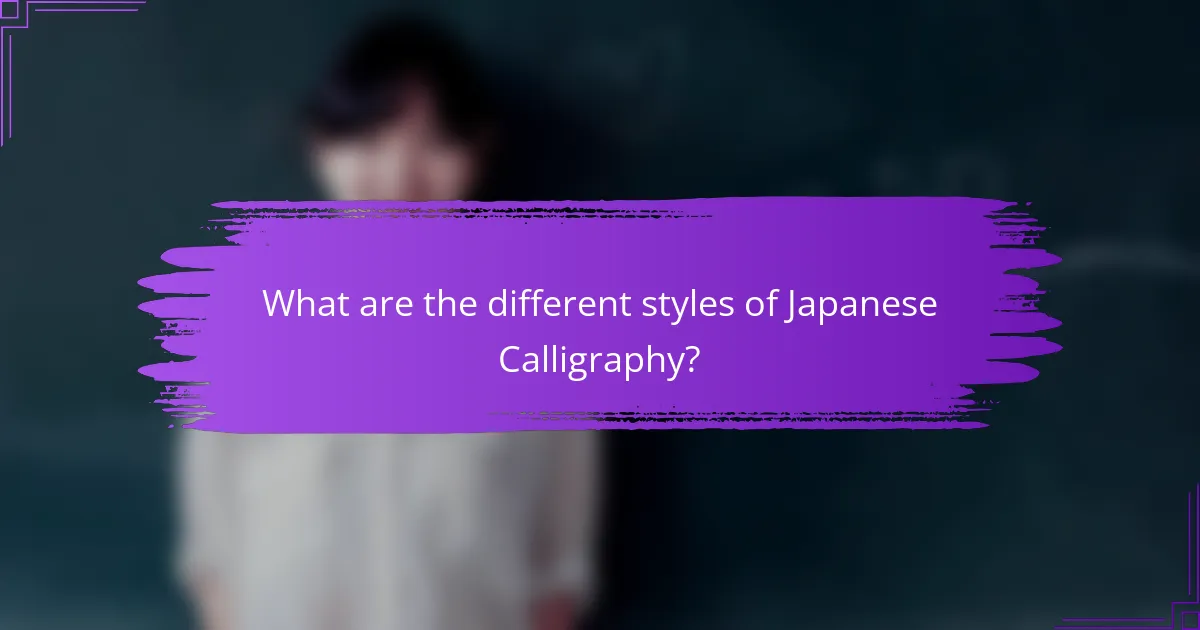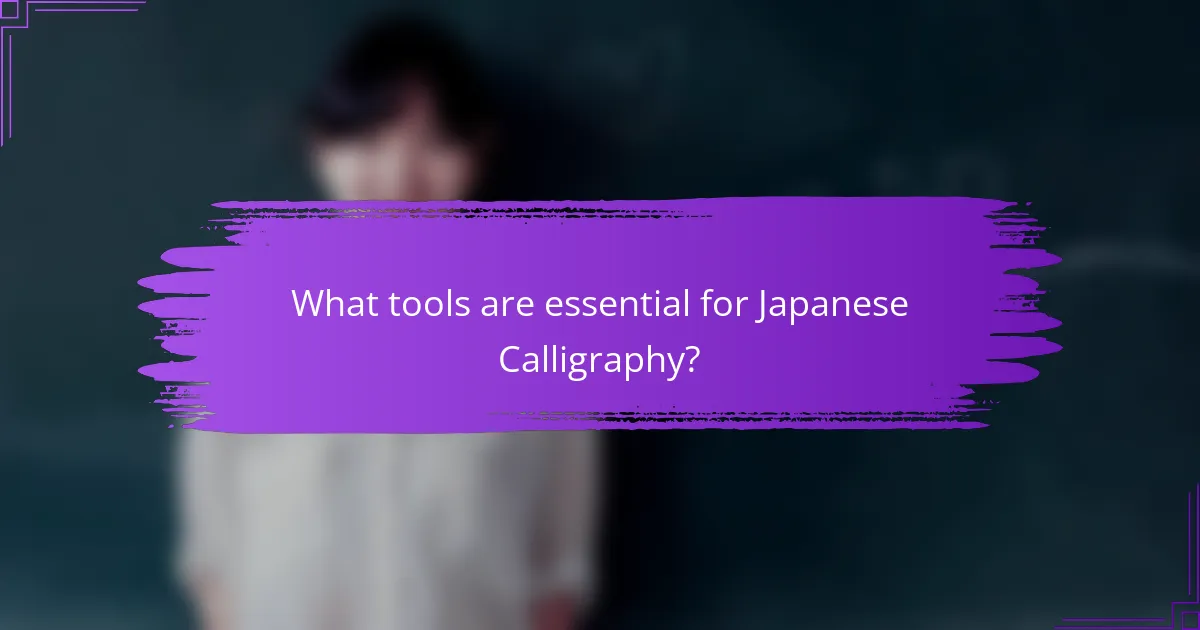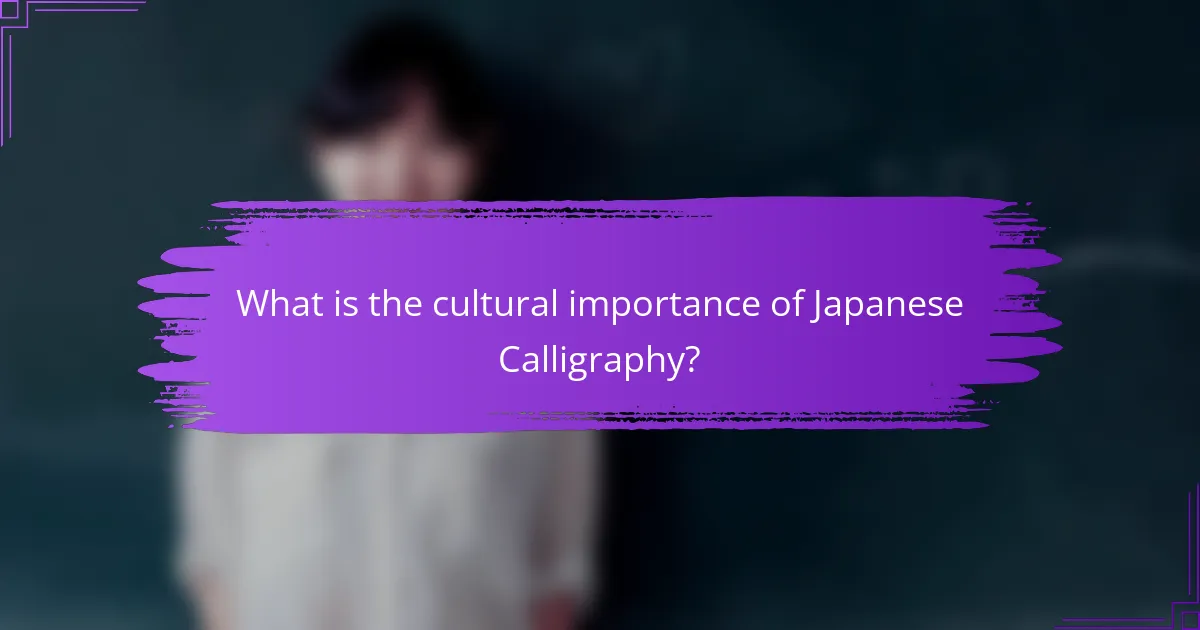
What is Japanese Calligraphy?
Japanese calligraphy, known as “shodō,” is the art of writing characters with brush and ink. This practice emphasizes the beauty of form and fluidity of movement. Shodō combines aesthetics with the expression of emotion. It is deeply rooted in Japanese culture and history. The technique involves using different brushes and ink types. Each stroke is deliberate and reflects the artist’s spirit. Japanese calligraphy is not just writing; it is a form of meditation. It has been practiced for centuries, evolving from Chinese calligraphy influences.
How did Japanese Calligraphy originate?
Japanese calligraphy originated from Chinese writing systems. It was introduced to Japan in the 5th century through cultural exchanges. Initially, Japanese calligraphy used Chinese characters, known as kanji. Over time, unique styles and scripts developed, including hiragana and katakana. The art form became influential in Japanese culture during the Heian period. Calligraphy was practiced by nobility and monks, emphasizing aesthetics and [censured]. Notable figures, like the poet Ono no Takamura, contributed to its evolution. Today, Japanese calligraphy remains a respected art form, blending tradition with contemporary expression.
What historical influences shaped Japanese Calligraphy?
Japanese calligraphy was shaped by several historical influences. The introduction of Chinese characters in the 5th century significantly impacted its development. This period marked the beginning of kanji adoption, which influenced the style and technique of Japanese writing.
During the Heian period (794-1185), the creation of kana scripts further transformed calligraphy. Kana allowed for more fluid and expressive writing, reflecting Japanese phonetics. The aesthetic principles of Zen Buddhism also played a crucial role in shaping calligraphic styles, emphasizing simplicity and spontaneity.
The Edo period (1603-1868) introduced various schools and styles, leading to diversification in techniques. Prominent calligraphers emerged, each contributing unique interpretations and innovations. The influence of tea ceremonies and other cultural practices further integrated calligraphy into Japanese art.
Thus, Japanese calligraphy evolved through a blend of Chinese influence, native script development, religious philosophies, and cultural practices over centuries.
How has Japanese Calligraphy evolved over time?
Japanese calligraphy has evolved significantly over time. Initially, it was influenced by Chinese calligraphy, adopting similar brush techniques and styles. In the 8th century, Japanese calligraphy began to develop its unique identity. The introduction of kana scripts in the 9th century allowed for greater expression in the Japanese language. During the Heian period (794-1185), calligraphy became an art form, reflecting personal style and emotion. The Edo period (1603-1868) saw the rise of various schools and styles, such as the Kanji and Kana calligraphy. Modern Japanese calligraphy incorporates contemporary themes while preserving traditional techniques. Today, it remains a respected art form, blending historical influences with modern expression.
What are the core principles of Japanese Calligraphy?
The core principles of Japanese calligraphy include balance, harmony, and fluidity. Balance refers to the visual equilibrium of characters on the page. Harmony emphasizes the relationship between the brush strokes and the overall composition. Fluidity involves the smooth, continuous movement of the brush. These principles guide the calligrapher in creating aesthetically pleasing works. Mastery of these elements often takes years of practice. Traditional techniques and tools, such as the brush and ink, are essential in achieving these principles. The historical significance of calligraphy in Japanese culture further underscores its importance.
What role does brush technique play in Japanese Calligraphy?
Brush technique is crucial in Japanese calligraphy as it directly influences the aesthetics and expression of the characters. The technique involves the control of brush pressure, angle, and speed. Mastering these elements allows calligraphers to convey emotion and intent through their work. Different strokes create varying thicknesses and textures, contributing to the overall visual impact. Historical texts emphasize that precision in brush technique reflects the calligrapher’s skill level and dedication. For instance, the use of a light touch can evoke grace, while a firmer stroke can express strength. Thus, brush technique is not merely functional; it embodies the philosophy and artistry of Japanese calligraphy.
How does the philosophy behind Japanese Calligraphy influence its practice?
The philosophy behind Japanese Calligraphy emphasizes harmony, balance, and expression. This philosophy influences practitioners to focus on the flow of brush strokes. It encourages a meditative approach, fostering mindfulness during creation. Practitioners often seek to convey emotions through each character. The concept of ‘ma’ or negative space is also significant. It teaches artists to appreciate silence and pauses in their work. This philosophical foundation shapes the aesthetic values present in calligraphy. It ultimately transforms writing into an art form that reflects the artist’s spirit.

What are the different styles of Japanese Calligraphy?
The different styles of Japanese calligraphy include Kaisho, Gyosho, and Sosho. Kaisho, also known as the block style, features clear and structured characters. Gyosho, or semi-cursive style, combines elements of both Kaisho and Sosho. Sosho, the cursive style, is characterized by flowing and connected strokes. Each style serves distinct purposes in artistic expression and communication. Historical texts and cultural practices have influenced these styles over centuries. The evolution of Japanese calligraphy reflects changes in aesthetics and societal values.
What are the major styles of Japanese Calligraphy?
The major styles of Japanese calligraphy include Kaisho, Gyosho, and Sosho. Kaisho is the standard block style, characterized by clear and distinct characters. It is often used for formal documents and learning purposes. Gyosho is a semi-cursive style, blending clarity with fluidity. This style is frequently used for artistic expression. Sosho is the cursive style, known for its flowing and abstract forms. It emphasizes speed and spontaneity in writing. Each style serves different purposes and reflects various cultural aspects of Japanese calligraphy.
How do different styles reflect cultural significance?
Different styles of Japanese calligraphy reflect cultural significance through their unique aesthetics and historical contexts. Each style embodies specific philosophies and cultural values. For instance, the Kaisho style emphasizes clarity and precision, symbolizing discipline and order in Japanese culture. The Gyosho style, known for its fluidity, represents spontaneity and personal expression, aligning with the Zen philosophy. The Sosho style, characterized by its cursive and abstract forms, conveys a sense of freedom and artistic interpretation. These styles are not merely artistic choices; they are deeply rooted in Japan’s historical evolution and societal norms. The evolution of these styles over time showcases the dynamic relationship between art and culture in Japan.
What are the unique attributes of each style?
The unique attributes of each style of Japanese calligraphy include distinct techniques, aesthetics, and historical significance. For example, the Kaisho style is characterized by its clear and legible forms. It emphasizes uniformity and precision, making it suitable for formal documents. The Sosho style, on the other hand, is known for its flowing, cursive strokes. This style prioritizes expressiveness and speed over legibility. The Gyosho style bridges the gap between Kaisho and Sosho. It combines elements of both, offering a balance of clarity and artistic flair. Each style reflects different cultural values and historical contexts within Japanese art.
How do traditional and modern styles compare?
Traditional Japanese calligraphy emphasizes classical techniques and materials. It often uses brush and ink on washi paper. The focus is on the beauty of each stroke and the flow of the characters. Traditional styles reflect historical and cultural significance. They prioritize harmony, balance, and spiritual expression.
Modern Japanese calligraphy incorporates contemporary influences and techniques. It may use different materials and tools, such as markers or digital media. Modern styles often experiment with form and abstraction. They reflect personal expression and innovation. The approach is less rigid, allowing for creative freedom.
Both styles share a foundation in brushwork and character formation. However, traditional styles maintain strict adherence to historical practices. In contrast, modern styles embrace evolution and change. This distinction highlights the dynamic nature of Japanese calligraphy.
What innovations have emerged in contemporary Japanese Calligraphy?
Contemporary Japanese Calligraphy has seen several innovations. Artists are integrating modern materials like acrylics and digital tools. This shift allows for new textures and colors not possible with traditional inks. Additionally, contemporary calligraphers are experimenting with mixed media. Techniques include combining calligraphy with painting and installation art. There is also a growing trend of using calligraphy in graphic design. This fusion attracts younger audiences and broadens the art form’s appeal. Workshops and exhibitions are increasingly showcasing these innovations. They highlight the evolution of calligraphy within modern artistic contexts.
How do traditional techniques influence modern practices?
Traditional techniques in Japanese calligraphy significantly influence modern practices by preserving cultural heritage and artistic integrity. These techniques emphasize the importance of brush control, ink application, and the flow of characters. Modern calligraphers often incorporate these foundational skills into contemporary designs. For instance, the use of traditional brushes remains prevalent, as they allow for expressive strokes. Additionally, the aesthetic principles of balance and harmony from traditional calligraphy are reflected in modern works. Historical practices, such as the emphasis on meditation and mindfulness during writing, continue to inform modern calligraphy workshops. This blend of old and new ensures that the essence of traditional Japanese calligraphy endures in contemporary art forms.

What tools are essential for Japanese Calligraphy?
The essential tools for Japanese calligraphy include the brush, ink, inkstone, paper, and mounting materials. The brush, known as “fude,” is crucial for creating strokes. It varies in size and shape for different styles. Ink is typically made from soot and mixed with water. The inkstone, or “suzuri,” is used to grind the ink stick into liquid form. Special paper, called “washi,” absorbs ink well and enhances the final appearance. Mounting materials are used for presenting the finished work. Each of these tools plays a vital role in achieving the art’s traditional aesthetic.
What are the primary tools used in Japanese Calligraphy?
The primary tools used in Japanese calligraphy are the brush, ink, inkstone, paper, and mounting materials. The brush, or “fude,” is essential for creating various strokes. It comes in different sizes and shapes, allowing for versatility in writing styles. Ink, traditionally made from ink sticks and water, is crucial for producing the desired color and consistency. The inkstone, or “suzuri,” is used to grind the ink stick into liquid form. Paper, known as “washi,” is specially designed for calligraphy, providing the right texture and absorbency. Mounting materials, including silk and decorative paper, are used to present finished works. Each tool plays a significant role in the art of Japanese calligraphy, contributing to its unique aesthetic and cultural significance.
How does the choice of brush affect the outcome of the calligraphy?
The choice of brush significantly impacts the outcome of calligraphy. Different brushes produce varying line thickness, texture, and fluidity. A soft brush allows for more expressive strokes, while a stiff brush creates precise lines. The brush’s size influences the scale of the characters. Larger brushes are suited for bold, sweeping movements. Smaller brushes enable intricate details and fine lines. Additionally, the material of the brush, such as animal hair, affects ink absorption and release. For instance, a brush made from sheep hair retains more ink than one made from weasel hair. This variation in ink application alters the overall aesthetic of the calligraphy. Thus, selecting the appropriate brush is essential for achieving the desired artistic effect in calligraphy.
What types of ink and paper are preferred in Japanese Calligraphy?
Japanese calligraphy primarily uses sumi ink and washi paper. Sumi ink is made from soot and animal glue, providing rich black tones. It is favored for its smooth flow and ability to create varying line thickness. Washi paper, made from mulberry bark, is preferred for its texture and absorbency. It allows for precise brush strokes and enhances the ink’s appearance. The combination of sumi ink and washi paper is traditional in Japanese calligraphy, ensuring high-quality results.
How can beginners choose the right tools?
Beginners can choose the right tools for Japanese calligraphy by considering specific attributes of each tool. First, they should select the appropriate brush, which comes in various sizes and shapes. A soft brush is ideal for beginners as it offers more flexibility. Next, they should choose quality ink that flows well and dries properly. Sumi ink is a traditional choice that provides rich color. Paper selection is also crucial; beginners should use washi paper designed for calligraphy. This paper absorbs ink well and enhances the writing experience. Finally, they should consider tool affordability and availability. Local art supply stores often carry beginner sets that include essential tools.
What should beginners consider when selecting brushes and ink?
Beginners should consider the type of brush and ink suited for their calligraphy style. Brushes come in various sizes and shapes, affecting line quality. A soft brush is ideal for fluid strokes, while a stiff brush offers precision. Ink quality is also crucial; traditional sumi ink provides rich, deep tones. Beginners should choose water-based ink for easier handling and cleanup. The size of the brush should match the scale of the work. For example, larger brushes work best for larger characters. Additionally, experimenting with different brushes and inks helps develop personal style.
How does the quality of materials impact practice and results?
The quality of materials significantly impacts practice and results in Japanese calligraphy. High-quality paper absorbs ink evenly, allowing for smoother strokes. This consistency enhances the fluidity of the brushwork. Additionally, premium brushes maintain their shape and provide better control. This leads to more precise characters. In contrast, inferior materials can cause blotting or uneven lines. Such issues detract from the aesthetic quality of the artwork. Studies show that artists using high-quality materials report higher satisfaction with their work. This satisfaction often translates into improved skills and results over time.

What is the cultural importance of Japanese Calligraphy?
Japanese calligraphy, known as “shodō,” holds significant cultural importance in Japan. It is regarded as a traditional art form that embodies the aesthetic principles of simplicity and elegance. Shodō is not merely writing; it is a meditative practice that promotes mindfulness and focus.
Historically, calligraphy has been a means of communication and expression. It has roots in Chinese calligraphy, which was introduced to Japan in the 6th century. Over centuries, Japanese calligraphy evolved, reflecting the unique cultural identity of Japan.
In contemporary society, shodō is celebrated in various cultural events and exhibitions. It serves as a bridge between past and present, connecting generations through shared appreciation. Calligraphy is also taught in schools, emphasizing its role in preserving cultural heritage.
The practice of shodō fosters discipline and patience, qualities highly valued in Japanese culture. It encourages the development of personal style and creativity. Overall, Japanese calligraphy remains a vital aspect of Japan’s artistic and cultural landscape.
How is Japanese Calligraphy perceived in Japanese culture?
Japanese calligraphy is highly regarded in Japanese culture as a revered art form. It embodies the principles of beauty, discipline, and [censured]. Practitioners, known as calligraphers, often undergo rigorous training to master techniques. This art form is not just about writing; it is a means of expressing emotions and thoughts. Calligraphy is seen as a reflection of the character of the writer. It is frequently displayed in homes, schools, and public spaces. Traditional events and ceremonies often feature calligraphy as a way to honor cultural heritage. The aesthetic appeal of calligraphy contributes to its significance in Japanese society.
What role does Calligraphy play in traditional ceremonies?
Calligraphy plays a significant role in traditional ceremonies by serving as a medium of artistic expression and cultural heritage. It enhances the aesthetic appeal of events such as weddings, tea ceremonies, and festivals. In these ceremonies, calligraphy is often used to inscribe meaningful phrases, blessings, or the names of participants on scrolls or decorative items. This practice emphasizes the importance of words and their visual representation in Japanese culture. Historical records indicate that calligraphy has been integral to Japanese rituals for centuries, reflecting the values and aesthetics of the time. The meticulous art form signifies respect and devotion, elevating the ceremonial experience.
How is Calligraphy integrated into other art forms?
Calligraphy is integrated into other art forms through its incorporation in painting, sculpture, and graphic design. In painting, calligraphic strokes enhance visual narratives and emotional expression. Traditional Japanese ink paintings often feature calligraphic elements that complement the imagery. In sculpture, calligraphy can be carved into materials, adding a textual dimension to three-dimensional works. Graphic design utilizes calligraphy to create unique typography, merging traditional art with modern aesthetics. Additionally, calligraphy appears in textiles, where it embellishes fabric patterns. This integration illustrates the versatility of calligraphy across artistic disciplines, enriching each form with its unique cultural significance.
What are the educational aspects of Japanese Calligraphy?
Japanese calligraphy, known as shodo, offers various educational aspects. It teaches the importance of discipline and patience. Students learn to control brush strokes and ink application. This art form enhances fine motor skills and hand-eye coordination. It also promotes cultural appreciation and historical awareness. Through practice, learners gain insight into Japanese aesthetics and philosophy. Calligraphy classes often incorporate lessons on traditional techniques and materials. Overall, shodo serves as a bridge between art and education in Japanese culture.
How is Calligraphy taught in schools and cultural institutions?
Calligraphy is taught in schools and cultural institutions through structured programs. These programs often include lessons on basic strokes and techniques. Students learn to use traditional tools, such as brushes and ink. Instruction typically covers various styles of calligraphy, emphasizing cultural significance. Cultural institutions may offer workshops and classes led by experienced calligraphers. Schools often incorporate calligraphy into art or language curricula. Students practice through exercises that develop their skills over time. This method fosters appreciation for the art form and its historical context.
What resources are available for those interested in learning Japanese Calligraphy?
Books on Japanese calligraphy provide foundational knowledge and techniques. Notable titles include “The Art of Japanese Calligraphy” by Yuuko Suzuki. Online courses are also available through platforms like Udemy and Skillshare. These courses often include video tutorials and practice exercises. Local community centers may offer workshops led by experienced calligraphers. Additionally, YouTube hosts numerous channels dedicated to calligraphy tutorials. Social media groups can connect learners with experienced artists for guidance. Calligraphy supply stores often provide instructional materials and tools. These resources collectively support beginners and advanced practitioners in mastering Japanese calligraphy.
What tips can enhance the practice of Japanese Calligraphy?
To enhance the practice of Japanese Calligraphy, focus on proper posture and grip. Maintaining an upright posture allows for better control of the brush. A relaxed grip on the brush promotes fluid movement.
Regular practice is essential for improvement. Consistency helps in mastering strokes and techniques. Studying traditional styles provides foundational knowledge. Learning from experienced calligraphers can offer valuable insights.
Using high-quality materials enhances the experience. Good paper and ink can significantly affect the outcome. Observing the balance and flow of characters is crucial. This attention to detail can elevate the artistry of calligraphy.
How can practitioners improve their brush control and technique?
Practitioners can improve their brush control and technique through consistent practice and focused exercises. Regularly practicing basic strokes enhances muscle memory. Utilizing various grip styles allows for better control and flexibility. Practicing on different surfaces can improve adaptability. Observing skilled artists provides insights into effective techniques. Engaging in slow, deliberate movements fosters precision. Using a mirror or video recording to review one’s technique can identify areas for improvement. Finally, receiving constructive feedback from experienced calligraphers can guide development.
What common mistakes should beginners avoid in Japanese Calligraphy?
Beginners in Japanese Calligraphy should avoid several common mistakes. One mistake is using the wrong brush size. A brush that is too large or too small can affect stroke quality. Another mistake is neglecting proper posture. Incorrect posture can lead to strain and poor control.
Additionally, beginners often rush their practice. Taking time to focus on each stroke is crucial for improvement. Failing to understand the importance of ink consistency is another error. The right ink thickness affects the overall appearance of characters.
Lastly, not studying traditional styles can hinder progress. Familiarity with various styles enhances skill development. By avoiding these mistakes, beginners can significantly improve their calligraphy.
Japanese calligraphy, known as “shodō,” is an esteemed art form that blends aesthetics with emotional expression, deeply rooted in Japanese culture and history. The article explores the origins of shodō, tracing its evolution from Chinese influences to the development of unique Japanese scripts such as hiragana and katakana. It examines the core principles guiding calligraphy, the significance of brush techniques, and the various styles, including Kaisho, Gyosho, and Sosho, each reflecting distinct cultural values. Additionally, the article outlines essential tools and materials, the educational aspects of calligraphy, and its cultural importance in traditional ceremonies and contemporary society.